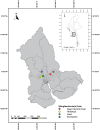Seroprevalence and associated risk factors of Toxoplasma gondii infection among slaughterhouse workers in Yangon Region, Myanmar: A cross-sectional study
- PMID: 37053192
- PMCID: PMC10101469
- DOI: 10.1371/journal.pone.0284352
Seroprevalence and associated risk factors of Toxoplasma gondii infection among slaughterhouse workers in Yangon Region, Myanmar: A cross-sectional study
Abstract
Background: Toxoplasmosis, having the significant consequences affecting mortality and quality of life, is still prevalent in various places throughout the world. The major gap in surveillance for Toxoplasma gondii infection among high-risk population, slaughterhouse workers, is an obstacle for the effective policies formulation to reduce the burden of toxoplasmosis in Myanmar. Therefore, this study aimed to assess the seroprevalence of toxoplasmosis and associated factors of seropositivity among slaughterhouse workers in Yangon Region, Myanmar.
Methods: A cross-sectional study that was conducted from June to November 2020 included 139 slaughterhouse workers involving at five main slaughterhouses under Yangon City Development Committee, Myanmar. The presence of IgG and IgM anti-T. gondii antibodies in serum was detected using the OnSite Toxo IgG/IgM Combo Rapid Test. A face-to-face interview was also performed using pretested structured questionnaires to obtain the detail histories: sociodemographic characteristics, level of knowledge, occupational factors, and environmental factors related to T. gondii infection. Bivariate logistic regression was used to determine the factors associated with T. gondii infection.
Results: Of all participants, the overall seroprevalence of anti-T. gondii was 43.9% (95% CI: 35.5-52.5%), of whom 98.4% (95% CI: 91.2-100.0%) were reactive only for IgG antibody and 1.6% (95% CI: 0.0-8.8%) were reactive for IgG and IgM antibodies. The significant factors associated with the seropositivity of T. gondii antibodies were blood transfusion history (OR: 5.74, 95% CI: 1.17-28.09), low level of knowledge (OR: 2.91, 95% CI: 1.46-5.83), contact with animal organs, muscles or blood (OR: 14.29, 95% CI: 1.83-111.51), and animals most frequently slaughtered (cattle) (OR: 3.22, 95% CI: 1.16-8.93).
Conclusions: A high seroprevalence of toxoplasmosis was detected among slaughterhouse workers in Yangon Region and it raises a significant public health concern. Therefore, providing health education regarding toxoplasmosis, enforcement of personal hygiene practices in workplaces, the establishment of training for occupational hygiene, and commencement of the risk assessment and serological screening for toxoplasmosis are crucial to curtail the prevalence of T. gondii infection among slaughterhouse workers.
Copyright: © 2023 Sint et al. This is an open access article distributed under the terms of the Creative Commons Attribution License, which permits unrestricted use, distribution, and reproduction in any medium, provided the original author and source are credited.
Conflict of interest statement
The authors have declared that no competing interests exist.
Figures
Similar articles
-
Prevalence and risk factors for exposure to Toxoplasma gondii in slaughterhouse workers in western Kenya.BMC Infect Dis. 2021 Sep 11;21(1):944. doi: 10.1186/s12879-021-06658-8. BMC Infect Dis. 2021. PMID: 34511066 Free PMC article.
-
Seroprevalence of anti-Toxoplasma gondii IgG antibody and risk factors among abattoir workers in Uyo, Southern Nigeria.Niger J Clin Pract. 2018 Dec;21(12):1662-1669. doi: 10.4103/njcp.njcp_44_18. Niger J Clin Pract. 2018. PMID: 30560833
-
Prevalence and predictors of Toxoplasma gondii infection in pregnant women from Dhamar, Yemen.BMC Infect Dis. 2019 Dec 30;19(1):1089. doi: 10.1186/s12879-019-4718-4. BMC Infect Dis. 2019. PMID: 31888517 Free PMC article.
-
Role of Toxoplasma gondii IgG Avidity Testing in Discriminating between Acute and Chronic Toxoplasmosis in Pregnancy.J Clin Microbiol. 2020 Aug 24;58(9):e00505-20. doi: 10.1128/JCM.00505-20. Print 2020 Aug 24. J Clin Microbiol. 2020. PMID: 32321784 Free PMC article. Review.
-
[Problems and limitations of conventional and innovative methods for the diagnosis of Toxoplasmosis in humans and animals].Parassitologia. 2004 Jun;46(1-2):177-81. Parassitologia. 2004. PMID: 15305712 Review. Italian.
Cited by
-
Assessing Hepatitis E Virus Seroprevalence among Slaughterhouse Workers in Western Saudi Arabia: Zoonotic Threats in Focus.J Epidemiol Glob Health. 2025 Apr 30;15(1):67. doi: 10.1007/s44197-025-00411-z. J Epidemiol Glob Health. 2025. PMID: 40304812 Free PMC article.
-
The global seroprevalence of Toxoplasma gondii infection in workers occupationally exposed to animals (1972-2023): a systematic review and meta-analysis.Vet Q. 2024 Dec;44(1):1-18. doi: 10.1080/01652176.2024.2396577. Epub 2024 Aug 29. Vet Q. 2024. PMID: 39205625 Free PMC article.
References
MeSH terms
Substances
LinkOut - more resources
Full Text Sources
Medical
Miscellaneous


